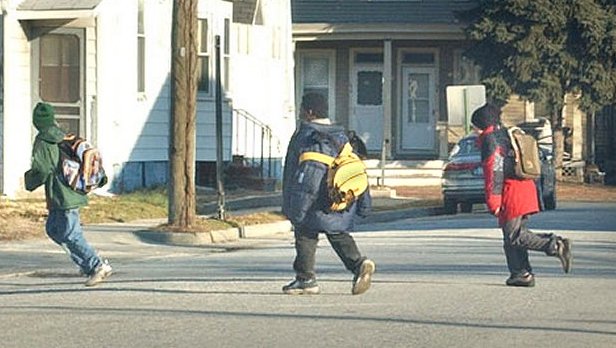 |
||||||||||||||||||||||||
|
|
||||||||||||||||||||||||
 |
||||||||||||||||||||||||
 |
||||||||||||||||||||||||
|
||||||||||||||||||||||||
 |
 |
|||
 |
||||
|
In the early part of the century, books were carried to and from school in hand. As society was able to afford more books, they were bound by straps and depending upon weight, carried by the strap or in the child's arms. As even more books were available, some carried brief cases. Today, children have so many books they must carry them in backpacks. Backpacks can be useful tools and many come with multiple compartments to help with organization and weight distribution. Compared with shoulder bags, briefcases or purses, a backpack is a better choice because it makes use of the strongest muscles in the body, the back and abdominal muscles, to support the weight. When used properly, the weight is evenly distributed across the child's body, shoulder, and neck thus making the child less prone to injury. Waist belts help distribute the weight to the lower body so the hips and legs bear some of the load. Many of us grew up hearing that a lot of homework would never hurt us. However, that is now proving false as over 50% of children carry backpacks heavier than 15% of their body weight on a daily basis. The average weight of a teen's backpack is 40 lbs. Repeatedly lifting this load ten or more times a day may create fatigue and repetitive stress injuries. More than 3300 children between the ages of 5 and 14 years were treated in emergency rooms for backpack related injuries in 1998. That number has grown considerably since then and must include children who are seen in doctor's offices or who suffer in silence. As many as 30% to 50% of 15- to 16-year-olds have some back pain. Over 58% of orthopedists reported treating children with back or shoulder pain from carrying backpacks. Pediatricians and chiropractors are reporting epidemic proportions of back pain and injuries in middle and high school students. Those numbers will only increase with time, unless the parents and schools take preventive measures. Lifetime pain may begin in early school years. Backpack wearers should walk normally. Their shoulders should be down and back and their abdominal muscles tightened. Now look at the average student who is carrying 25% or more of their body weight in their pack. Look at an 80 pound sixth grader carrying a 40-pound backpack. The child is either hyperextended (arching their back) or hunched over with the shoulders rounded and the head jutting forward. This is putting strain on the muscles of the neck and back and causing the fascia to become bound and increasing fatigue and the risk of injury. As the child grows and spends more time in this position, they will not be able to correct this posture. This will lead to back problems, neck problems and increase chances of injury as they try to force the body into a different posture to play sports or participate in other activities. Also, a pack that is too heavy or has shoulder straps that are too narrow may dig into the child's shoulders. This may cause nerve damage and impede blood and lymph flow throughout the body and brain. This means important nutrients needed for brain and body development and growth are not arriving in a timely manner, which may cause developmental delays or damage to organs and tissues. Also, if lymph fluids are impeded, body wastes are not being removed properly and toxins may build up in the cells and cause illness over time. The most common symptom reported by backpack users is "rucksack palsy." This occurs when pressure on the nerve in the shoulder causes numbness in the hands, muscle wasting and if left untreated, nerve damage. Parents must take action to prevent injury before it occurs. The first step is to be active in the school and be aware of what is being required of the child. Take action with the school to limit the number of books required for homework and to make books available either on CD ROM or online to reduce the number of items that must be carried by the child. Make sure the children are allowed time between classes to go to their lockers rather than having to carry their day's supplies on their backs. Purchase paperbacks or keep a second set of books at home, if possible. For things that must be carried, the most important step is to choose the right size backpack for your child, not the maximum load capacity. It should not be wider or longer than the child's torso. (The torso is the part of the body that extends from the bony bump at the base of the neck to the top of the hips.) The maximum weight of the loaded backpack should not exceed 15% of the child's bodyweight. The Occupational Therapy Association recommends the weight be kept between 10% and 20% of bodyweight. The American Academy of Physical Medicine and Rehabilitation produced a study that showed students carrying packs weighing 25% of their bodyweight exhibited balance problems while performing normal activities, such as climbing stairs or opening doors. Carrying 15% of bodyweight improved balance but those who carried no more than 5% of their bodyweight were the most effective at maintaining their balance. A child who is off balance is more prone to falls and injury. If the style or weight of the backpack forces the child to bend forward, lean backward or lose their balance, it is either the wrong style, overloaded, or both.
Parents must teach the child to use the backpack properly. Load heavier items closer to the body. Use all the compartments to distribute the weight evenly. Place items that might poke through the fabric, such as scissors, in protective containers. Never overload the backpack. It should never carry more weight than the child can carry in their arms for a few minutes. Clean the backpack out every night to be sure that only essential items are being carried. Teach the child to pick up the pack by facing it, bending at the knees, checking the weight with both hands and then lifting with the legs. Put one shoulder strap on first and then the other. Make sure the shoulder straps are snug, but not too tight. Also, make sure the child always uses the waist or chest strap to help distribute the weight more evenly across their body. Check that the backpack is evenly centered in the middle of the child's back. It should not be hitting the neck or be lower than 4" below the waist. A properly adjusted backpack can reduce the biomechanical stress on the developing spine. No one should ever carry a heavy backpack over one shoulder. Doing so may cause serious postural misalignments. Areas of the spine may become restricted and vertebrae may be forced out of alignment. This will affect not only movement but balance and may lead to more serious injury and pain later. Carrying a backpack alters the fluid content of the discs. This may lead to disc herniation, degeneration in the spine and other spinal disorders. This affects the spine's natural shock absorption abilities and makes it vulnerable to damage from repetitive stress or daily activities. Many parents and health professionals try to correct the posture problem by making the children do posture exercises, yoga or weight training. However, they are not addressing the fascia that has become bound or tightened because of the strain on the body. Therefore, the exercises at best may do no good and at worst may cause further injury. Before using exercise, the child should be evaluated for proper posture and balance. Restrictions should be released and proper alignment established so the child may do the exercises properly and benefit from them without increasing risk of injury. At Windsong Therapy and Wellness, we look at the child's developing body and release areas of restriction to encourage proper balance, development and growth. After misalignments have been corrected, an individual exercise plan can be established that will fit into the family's lifestyle. |
| [Home] [Backpack Safety Tips] |
|
This website last updated on 31 July 2010 This website is entirely funded by Windsong Therapy and Wellness, Inc. |
|
Disclaimer: Confidentiality of data relating to individual patients and visitors, including their identity, is respected by this Web site. The owners of this Web site undertake to honor or exceed the legal requirements of medical / health information privacy that apply in Texas and the United States. The information on this Web site is Copyright © 1999-2008 Windsong Therapy and Wellness, Inc. Please obtain permission from Windsong Therapy and Wellness, Inc. before reproducing any information from this Web site. |